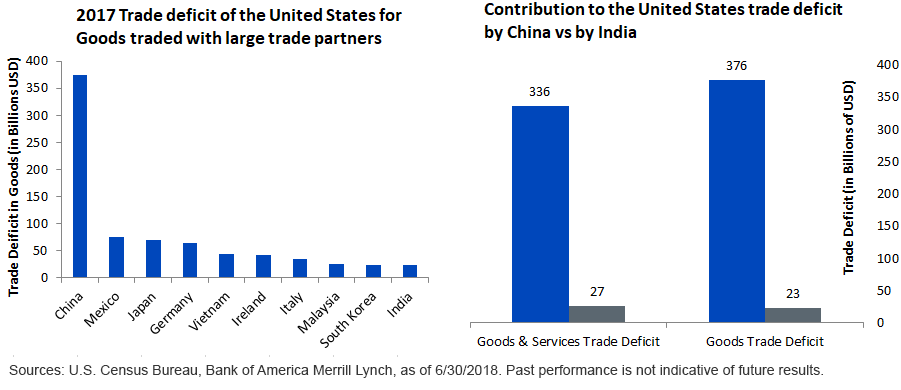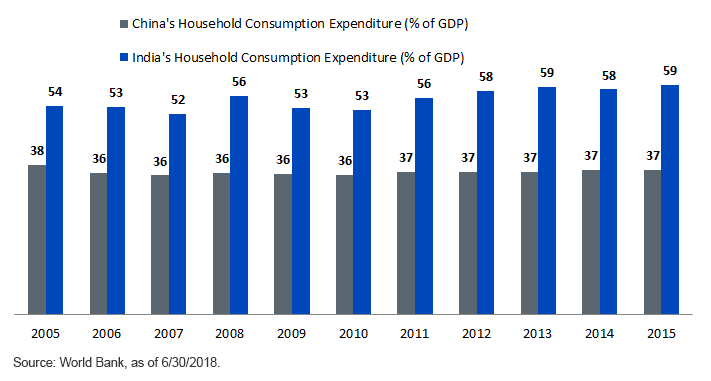This Tiger Can Potentially Trump Trade-War-Led Sell-off


Financial markets have been jittery for some time now because of concerns that trade tensions could lead to a full-fledged trade war. While fair trade is essential for sustainable long-term deals, I am not here to approve or disapprove of trade tariffs of any kind.
My goal in this analysis is to examine large trading partners of the U.S. and identify which countries are the smallest and biggest contributors to the trade deficit of the U.S. This might help us identify countries that could act as a shelter during a trade-war-driven sell-off while providing good long-term growth opportunities amid general market volatility.
U.S. Trading Partners—India Is an Unlikely Foe
The figure below on the left plots the contribution of large trading partners to the U.S. 2017 trade deficit for goods. China alone accounted for roughly $376 billion, or 46%, of the total U.S. deficit in goods. On the other extreme end, India contributed $23 billion—a little under 3% of the total U.S. deficit!1 The figure on the right below shows the contribution by China and India to the U.S. trade deficits plotted next to each other.

If investors are worried about a trade war, then China is a risk factor while India is less likely to be a target. Most of India’s exports to the U.S. are in services and in goods such as pharmaceuticals, jewelry, apparel and less-high-profile items such as steel and aluminum. This also makes India an unlikely target from a political appeasement perspective.
China vs. India: Investments vs. Consumption
What makes India even more interesting in a world connected with a global supply chain is that it is a highly inward-driven economy. As China built its infrastructure over the last decade, investments were the dominant part of the gross domestic product (GDP), and consumption took a secondary position. For years now, investors have wondered if as the Chinese economy matures it could reinvent itself as a more consumption-based economy. While this is a stated goal over the long term, in the short run China continues to be an investment-driven economy.
India, on the other hand, has taken a very different approach. Consumption is the key driver of India’s economy. This is typically seen in developed economies that have surpassed the initial growth phase of investments and are now mostly consumption societies.
Rising Middle Class Fueling India's Consumption-Oriented Growth

I recently wrote a post about countries with the fastest growth in large- and small-cap companies; India stood in the top spot because of its fast growth rates in GDP and favorable demographics. Thus, when we combine the two facts on growth rates and consumption together:
- India stands out as the world’s fastest-growing large and accessible economy.
- Consumption-driven growth makes India less exposed to global supply chains.
Key Risks
There are risks, and I do not intend to say that India is immune to a global sell-off or any political risk. Below are a few quick risks, in my opinion:
- Oil Prices and U.S.-Iran Sanctions: Being the third-largest oil importer—it imports about 80% of its energy needs—India is heavily dependent on global oil prices. India is also a big buyer of Iranian oil, which accounts for about 30% of exports by Iran. The U.S. has been nudging India to cut its supply from Iran and buy elsewhere, and, so far, India has responded favorably. Any significant rise in oil prices or change in oil-driven politics could put downward pressure on the rupee and may dent consumers’ spending power. Because India deregulated oil prices during the fall a few years back , a jump in oil prices today does not imply the same fiscal drag it used to.
- Global Risk-off and Equity Sell-off: If there is a risk-off rally and investors dump international equities and rotate to defensive domestic stocks or Treasuries, Indian equities would be likely negative too.
- Federal Reserve (Fed) Rate Hike and Currency: A faster-than-anticipated rate hike by the Fed can jolt emerging market currencies and the rupee, and this may be a drag on equity performance. Because of a possible inverted yield curve, a super-aggressive Fed looks less likely. For details, read the analysis here by my fixed income colleague.
Key Opportunities and Conclusion
It’s impossible to summarize all that India has to offer in few sentences, but, at a super high level, here are a few quick opportunities:
- Growth Aspirations: India is a very young country, with three-fourths of its population below 35 years of age. This makes India a demographics gold mine.
- Global Playing Fields: Firms from Amazon to Alibaba and from Walmart to Apple have been taking note of India’s growth and have been expanding their bases in India. India is Amazon’s biggest investment destination outside the U.S., and Walmart recently acquired local e-commerce giant Flipkart for $15 billion to compete with Amazon directly. All of this reflects what some of the smartest business minds globally are thinking when it comes to expansion.2
- Consumption Shield: A knee-jerk reaction by investors during a trade-war sell-off would cause Indian equities to go down. However, when good sense prevails and as consumption continues to fuel India’s growth in the medium term, Indian stocks stand to outperform.
For long-term investors who are willing to invest in international equities, India offers a great mix of growth with relative protection from trade tensions.
The WisdomTree India Earnings Fund (EPI) offers a unique methodology of selecting only profitable companies from India’s stock market and then weighting by their dollar amount of profits. With its over 10 years of live history, EPI is an easy way for investors to allocate to profitable companies in India. Here is how you can seek smarter exposure to India’s stock markets.
1U.S. Census Bureau, as of 6/30/2018.
2Please visit our website to see which ETFs hold these securities.
Important Risks Related to this Article
There are risks associated with investing, including possible loss of principal. Foreign investing involves special risks, such as risk of loss from currency fluctuation or political or economic uncertainty. This Fund focuses its investments in India, thereby increasing the impact of events and developments associated with the region which can adversely affect performance. Investments in emerging, offshore, or frontier markets such as India are generally less liquid and less efficient than investments in developed markets and are subject to additional risks, such as risks of adverse governmental regulation and intervention or political developments. As this Fund has a high concentration in some sectors, the Fund can be adversely affected by changes in those sectors. Due to the investment strategy of this Fund, it may make higher capital gain distributions than other ETFs. Please read the Fund’s prospectus for specific details regarding the Fund’s risk profile.


